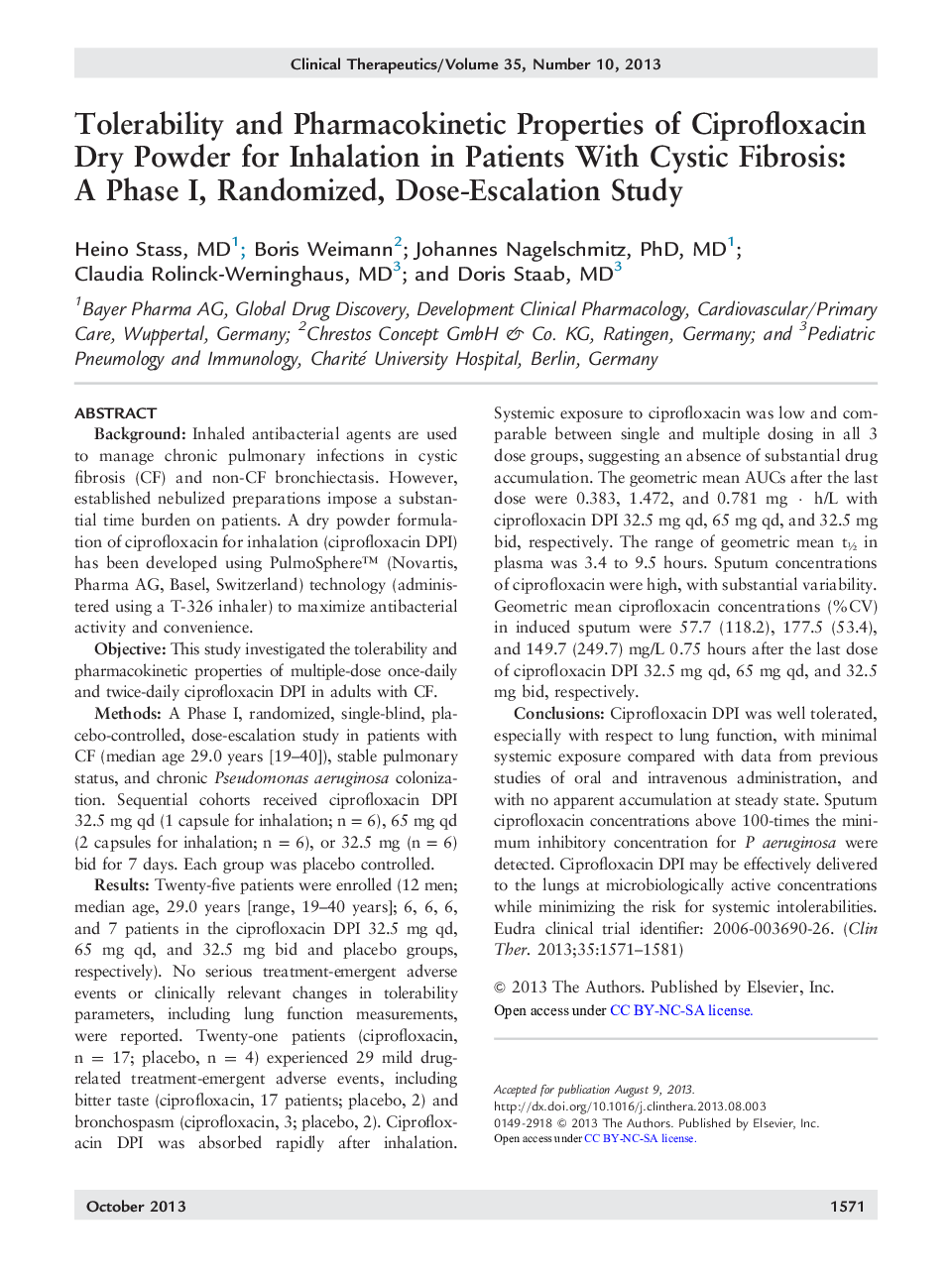| کد مقاله | کد نشریه | سال انتشار | مقاله انگلیسی | نسخه تمام متن |
|---|---|---|---|---|
| 5825630 | 1119914 | 2013 | 11 صفحه PDF | دانلود رایگان |

BackgroundInhaled antibacterial agents are used to manage chronic pulmonary infections in cystic fibrosis (CF) and non-CF bronchiectasis. However, established nebulized preparations impose a substantial time burden on patients. A dry powder formulation of ciprofloxacin for inhalation (ciprofloxacin DPI) has been developed using PulmoSphere⢠(Novartis, Pharma AG, Basel, Switzerland) technology (administered using a T-326 inhaler) to maximize antibacterial activity and convenience.ObjectiveThis study investigated the tolerability and pharmacokinetic properties of multiple-dose once-daily and twice-daily ciprofloxacin DPI in adults with CF.MethodsA Phase I, randomized, single-blind, placebo-controlled, dose-escalation study in patients with CF (median age 29.0 years [19-40]), stable pulmonary status, and chronic Pseudomonas aeruginosa colonization. Sequential cohorts received ciprofloxacin DPI 32.5 mg qd (1 capsule for inhalation; n = 6), 65 mg qd (2 capsules for inhalation; n = 6), or 32.5 mg (n = 6) bid for 7 days. Each group was placebo controlled.ResultsTwenty-five patients were enrolled (12 men; median age, 29.0 years [range, 19-40 years]; 6, 6, 6, and 7 patients in the ciprofloxacin DPI 32.5 mg qd, 65 mg qd, and 32.5 mg bid and placebo groups, respectively). No serious treatment-emergent adverse events or clinically relevant changes in tolerability parameters, including lung function measurements, were reported. Twenty-one patients (ciprofloxacin, n = 17; placebo, n = 4) experienced 29 mild drug-related treatment-emergent adverse events, including bitter taste (ciprofloxacin, 17 patients; placebo, 2) and bronchospasm (ciprofloxacin, 3; placebo, 2). Ciprofloxacin DPI was absorbed rapidly after inhalation. Systemic exposure to ciprofloxacin was low and comparable between single and multiple dosing in all 3 dose groups, suggesting an absence of substantial drug accumulation. The geometric mean AUCs after the last dose were 0.383, 1.472, and 0.781 mg · h/L with ciprofloxacin DPI 32.5 mg qd, 65 mg qd, and 32.5 mg bid, respectively. The range of geometric mean t½ in plasma was 3.4 to 9.5 hours. Sputum concentrations of ciprofloxacin were high, with substantial variability. Geometric mean ciprofloxacin concentrations (%CV) in induced sputum were 57.7 (118.2), 177.5 (53.4), and 149.7 (249.7) mg/L 0.75 hours after the last dose of ciprofloxacin DPI 32.5 mg qd, 65 mg qd, and 32.5 mg bid, respectively.ConclusionsCiprofloxacin DPI was well tolerated, especially with respect to lung function, with minimal systemic exposure compared with data from previous studies of oral and intravenous administration, and with no apparent accumulation at steady state. Sputum ciprofloxacin concentrations above 100-times the minimum inhibitory concentration for P aeruginosa were detected. Ciprofloxacin DPI may be effectively delivered to the lungs at microbiologically active concentrations while minimizing the risk for systemic intolerabilities. Eudra clinical trial identifier: 2006-003690-26.
Journal: Clinical Therapeutics - Volume 35, Issue 10, October 2013, Pages 1571-1581